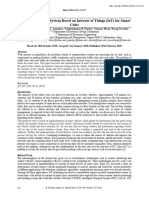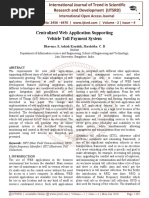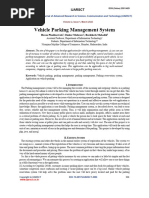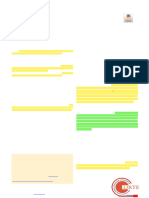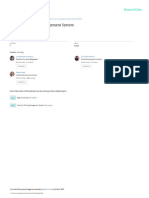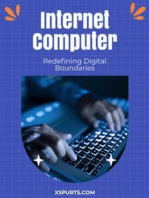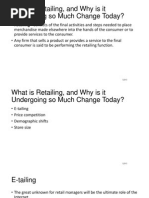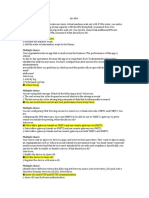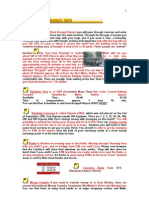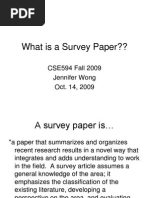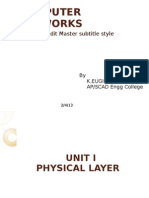IJCRT2205871
IJCRT2205871
Uploaded by
dharmendratyagi232Copyright:
Available Formats
IJCRT2205871
IJCRT2205871
Uploaded by
dharmendratyagi232Copyright
Available Formats
Share this document
Did you find this document useful?
Is this content inappropriate?
Copyright:
Available Formats
IJCRT2205871
IJCRT2205871
Uploaded by
dharmendratyagi232Copyright:
Available Formats
www.ijcrt.
org © 2022 IJCRT | Volume 10, Issue 5 May 2022 | ISSN: 2320-2882
E-Challan: Digital Traffic/Transport
Enforcement Solution System
Ali Saif Aviral Mittal Parth Tyagi
Information Technology, Noida Institute Of Information Technology, Noida Institute Of Information Technology, Noida Institute Of
Engineering And Technology, Greater Engineering And Technology, Greater Engineering And Technology, Greater Noida-
Noida-201310, India Noida-201310, India 201310, India
Pavitra Rajput Tanya Varshney
Information Technology, Noida Institute Of Noida Institute of Engineering And
Engineering And Technology, Greater Technology, Greater Noida-201310,India
Noida-201310, India
anywhere. In the following sections a detailed methodology
ABSTRACT along and a comparative study with the past works is done to
The aim of this paper is to expand an online platform to provide a detailed overview about the E-Challan system.This
facilitate the drivers and the visitor's police to manipulate the Project is mainly about an e-governance management system
penalties for site visitor violations. E-challan system is the which allows different features to the stakeholders related to
online platform aimed at presenting a wide variety of assist in challan, vehicle details and license details. The Software has
managing and monitoring the traffic penalties, supporting different types of users who are dependent on each other for the
customers concerning the issues they face in paying for his or fully functioning of the application. The Software allows to
her challan. The e-challan system is largely an interplay create and maintain a database containing information about
between police and drivers without problems thru an internet different registered users, their license details and challans
platform or an app. This assignment prototype describes how issued. The system also maintains a database of vehicles which
challan will become smooth for customers thru retaining it are registered in the local RTO. This information can be used
online. The net platform pursuits to lessen the office work, to verify drivers and in case of any violation of traffic rules to
guide techniques, and boom the benefit for the users. issue a challan to the driver. Also, the software allows the
system administrator to access and update the databases when
General Terms a new driver or vehicle is registered. The system admin also
Web Application, Traffic Penalty, E- Governance. creates initial login credentials for the traffic department
personnel. The administrator is the sole authority who can
Keywords manipulate all the information in these databases.
E-penalty, E-challan, Traffic Violation
2. LITERATURE SURVEY
1. INTRODUCTION A detailed survey of existing projects and models was done to
Governance is a challenge in a country as diverse, vast and arrive on a foolproof and successful model.
rapidly developing as India. India needs a new and latest The paper [1] discusses an electronic governance model of
technology for large-scale transformation and implementation electronic challan and traffic penalty system using an
of government plans. While India is among the fastest integrated existing method of penalty in India.
developing economies in the world, India's equitable growth
remains a critical imperative. This project is an attempt in this A comparable approach is accompanied via [2] which implements
very direction of e-governance for a country like India with a the version the use of an automated challan system the usage of
large population and high density. MATLAB. The model captures the photograph of the automobile
and extracts the number plate of the vehicle which breaches the
India's avenue network has grown at an annual price of 4% for traffic law. The version in addition methods to generate an
the reason that 1951. In conjunction with the agricultural and automated e- challan which can be at once paid by way of the driving
urban population density, the density of roads has risen in India. force on the RTO workplace or can avail other online bills
The rising population has resulted in more vehicles on roads. additionally. The assignment in particular specializes in character
This has caused an excessive price of injuries. One of the main statistics extraction from more than one databases.
reasons for the excessive range of injuries on the road is that
site visitors' regulations are violated and now not accompanied. The paper [3] discusses the traffic violation detection using
In keeping with a survey, 78% of the injuries appear because of computer vision. The model extracts the license plate using a new
violation of visitors policies by means of the driver along with deep learning network structurewhich is used to detect and locate
dashing, riding underneath the influence of alcohol or tablets, the license plate automatically. The vehicle no is detected and the
and hit and run instances. information of the owner is extracted. The information is used to
generate an E-Challan and an instant appropriate fine message is
India needs a highly regulated foolproof system of sent to the owner. Implementation of the whole model is very
governance to prevent these avoidable accidents and efficient and requires very less human intervention.
manage the traffic onthe roads. A system which makes the
people follow the rules and drive safely, without violating
any rules. E-Challan is thatfoolproof regulated system. E-
Challan is an online E-governance system to facilitate the
traffic managers to manage the traffic violation as well as
for the drivers to manage the penalties. E-Challan provides
a wide range of support needed for managing and
monitoring traffic penalties. It is also a type of
decentralized information system which allows all the
stakeholders to access the needed information anytime
IJCRT2205871 International Journal of Creative Research Thoughts (IJCRT) www.ijcrt.org h441
www.ijcrt.org © 2022 IJCRT | Volume 10, Issue 5 May 2022 | ISSN: 2320-2882
Each of the users have been provided with a variety of different
A novel approach is discussed in the paper [4] proposing an functionalities and resources which they can use on the online
efficient e-challan generation technique using OCR, platform with verified login credentials.
generating challan using android application. The application
works by detecting the plate, then fetching the details from the
database and generating the challan. A similar approach is used
by [7] suggesting the need of an efficient and smart automated
traffic penalty generation system. The authors suggest the
retrieval of information of vehicles from the official database
using smartphones, by scanning the QR code. The officer can
then generate an e-challan with the app and the challan will be
sent to the driver using SMS.
A new IOT based automatic penalty charging approach is
suggested by [5]. The authors have used the IOT based
approach for development of the solution for violation of traffic
rules using microcontrollers, RFID, LCD interfacedwith AVR.
The proposed system will continuously monitor the vehicles
using RFID readers and transceivers, and will automatically
generate a challan for violation of any traffic rules. If the driver
fails to pay the charges in a given period of time, the regional
transport office (RTO) may suspend the license of the driver.
The paper [6] presents a system called TRuVIS (Traffic Rule
Violation Information System) which is basically an alert
system developed using Arduino, which regulates, monitors
and takes action against rule violation by the driver. The system
generates a challan and sends the notification to the driver’s
phone. The application is developed mainly for regulating the
horn violation.
The paper [7] discusses the disadvantages of manual e- challan
generating process, the problem of fake challans, loss to the Fig 1: Stakeholders and use case diagram
government and inconvenience caused to the driver. The
author suggests a smart automatic e-challan system based on
3.2 Determining the requirements of the
RFID and GPS modules. The system can locate the vehicle stakeholders
using the GPS and the official can generate a challan using the (A) TRAFFIC POLICE PERSONNEL:
information of the vehicle saved in the database, which will
1. The new personnel SHALL be issued an initial login
be then sent to the owner of the vehicle using SMS.
ID and a password by system administrator.
3. METHODOLOGY 2. The new personnel SHALL be able to generate
The paper presents a web-application developed with a step his/her login ID and a password
by step methodology as discussed below.
3. The personnel SHALL be able to login using his or
3.1 Define the stakeholders of this web- her ID and password.
application. 4. The personnel SHALL be able to reset his or her
There are 3 distinct type of users on the platform namely: password in-case he or she forgets it.
1. Traffic Police Personnel: The registered employee of 5. The personnel SHALL be able to input the details of
the traffic police who can issue the challans to the the license.
drivers who have violated any traffic rules across
the city. 6. The personnel SHALL be able to get the details of
the owner of the license.
2. Drivers: The licensed people who have been
permitted to drive the vehicles across the city and 7. The personnel SHALL be able to input the details of
have been issued a challan due to violation of any the vehicle.
traffic rules. These people can pay and manage their 8. The personnel SHALL be able to get the details of
issued challan on the platform. the owner of the vehicle.
3. System Administrator: The system administrator is 9. The personnel SHALL be able to input the details
responsible for the management of accounts of the required for issuing the challan like offence, location,
above users and is responsible for issuing login time and comments.
credentials to the traffic police personnel, and
insertion of new vehicle, driver and license details 10. The personnel SHALL be able to issue a challan
in the database. successfully.
11. The personnel SHALL be able to see the challan
history of the driver.
12. The personnel SHALL be able to see the challans
issued by himself or herself.
IJCRT2205871 International Journal of Creative Research Thoughts (IJCRT) www.ijcrt.org h442
www.ijcrt.org © 2022 IJCRT | Volume 10, Issue 5 May 2022 | ISSN: 2320-2882
(B) DRIVER: 3.4 Using Technical Specs develop the web-
1. A new driver SHALL be able to sign-up application.
himself/herself using his/her general information The project has used a variety of front and back end
like his license details, email and phone number. frameworks for implementations such as:
2. The new driver SHALL be able to generate his/her 1. HTML: For front-end development
login ID and a password 2. CSS: For front-end development
3. The driver SHALL be able to login using his or her 3. JS: For animations and display time
ID and password.
4. Php: For front and back end connections, session
4. The driver SHALL be able to reset his or her creation and queries
password in-case he or she forgets it.
5. AJAX: With Ajax, the net programs can send and
5. The driver SHALL be able to view his challan history retrieve facts from a server asynchronously without
6. The driver SHALL be able to view the challansissued interfering with the show and conduct of the present
to him by the traffic personnel. web page.
7. The driver SHALL be able to pay the issued challans 6. MySQL: Back end development
due for payment.
4. IMPLEMENTATION AND RESULTS
(C) SYSTEM ADMINISTRATOR: The utility gives a number of functions together with displaying
automobile info, displaying driver info, paying challan, and
1. The Administrator SHALL be able to login usinghis issuing challan. The center utility of the internet site is to the
or her ID and password. problem and pay the challan, the working of that is defined
2. The Administrator SHALL be able to reset his or within the following section.
her password in-case he or she forgets it.
Step 1: Personnel login:
3. The Administrator SHALL be able to generate new The visitors police employees login inside the internet-
admins by issuing them an initial login ID and software using his credentials. On his computing device he/she
password. can see all the functionalities which can be used by him/her.
For issuing the challan the personnel click on the problem
4. The Administrator SHALL be able to insert the challan icon and an issue challan form is opened.
details of the new vehicle registered.
5. The Administrator SHALL be able to insert the
details of the new license registered.
6. The Administrator SHALL be able to generate new
personnel credentials by issuing them an initial login
ID and password.
7. The Administrator SHALL be able to get the details
of personnel.
3.3 Determine the relationships between the
different entities and classes.
Fig 3: Personnel Login
Fig 2: Class Diagram
Fig 4: Personnel Desktop
IJCRT2205871 International Journal of Creative Research Thoughts (IJCRT) www.ijcrt.org h443
www.ijcrt.org © 2022 IJCRT | Volume 10, Issue 5 May 2022 | ISSN: 2320-2882
Step 2: Issue Challan: Step 3: Payment of the challan by the Driver:
The personnel will identify the visitor's violator and will input Just like site visitors personnel the driver will log in to the
his/her license no for you to display the automobiles registered internet- software and could arrive on his/her desktop. Via
with the driver. The police personnel can pick the automobile, choosing the pay challan icon, all the challans issued to the
vicinity, and offense from a drop-down list, after which click driver might be displayed, the driver can pick out the pay button
on the Issue challan button to issue the challan. The device will corresponding to the challan he desires to pay, and after
generate the challan and the info can be up to date inside the successful payment, the challan fee information might be
database. updated inside the database.
Fig 8: Driver Desktop
Fig 5: Enter License Number
Fig 9: Search Challan
Fig 6: Select Offense
Fig 10: Display of the challan details and
The payment details and the challan status will be updated in
the database.
Fig 7: Stored in the database
The next step will be by the driver, to whom the challan has
been issued, the driver will go to his/her desktop and pay the
challan.
IJCRT2205871 International Journal of Creative Research Thoughts (IJCRT) www.ijcrt.org h444
www.ijcrt.org © 2022 IJCRT | Volume 10, Issue 5 May 2022 | ISSN: 2320-2882
Fig 11: Architecture of the web-application
5. CONCLUSIONS
[4] Dubey, R. S., & Warker, K. V. (2017, June). An
The undertaking specifically makes a speciality of problem and effective approach for e-challan for traffic violator using
look at or pay challan along with information extraction of picode. In 2017 International Conference on Intelligent
automobiles, license numbers, and challan information. The Computing and Control Systems (ICICCS) (pp. 810-813).
venture may be extended to a complete-stack useful internet IEEE.
site inside the future presenting other features such as license [5] S Onah, K. (2018). DESIGN AND IMPLEMENTATION
advent, RTO vehicle registrations, and much greater. The OF TRAFFIC OFFENCE TRACKING
device also can be modified via using the contemporary SYSTEM (Doctoral dissertation, Godfrey Okoye
technology as discussed inside the literature survey like QR University Ugwuomu Nike, Enugu).
Code and RFID scanners. This could restrict human
intervention and bring about a greater green version of the [6] Welekar, A. R., Dahake, R. S., Bodhane, S. M., Wawre,
existing system. T. B., Umbarkar, R. P., & Ghormode, P. S. (2018).
Analysis of Rules Violation & Efficient E-Challan
6. ACKNOWLEDGMENTS Generation Using OCR In Real Time Traffic.
The authors are grateful to the Noida institute of engineering
[7] Jichkar, N., Deulkar, A., Thakare, A., Bolakhe, S., &
and Technology for imparting the platform, resources and
Vaidya, S. A Novel Approach for Automated E-challan
guide for this venture. The authors are also thankful to their
Generation using QR Code and OCR.
colleagues, Mrinal Bharadwaj, Shubham Shukla and Nishant
Ahlawat for their precious comments and feedback, constant [8] Dambe, A., Gandhe, U., & Bendre, V. (2013). Automatic
support, and assistance. penalty charging for violation of traffic rules.
International Journal of Advanced Research in Electrical,
7. REFERENCES Electronics and Instrumentation Engineering, 2(2).
[1] Goel, S. K., & Shukla, M. (2018). Enforcement of
Automatic Penalty (e-Penalty) to Control the Traffic Rule [9] Biswas, R., Beed, R. S., Seth, D., Pal, P., Basu, K., &
Violators in Digitized INDIA Using ICT. In Mukherjee, T. (2015). Traffic Rule ViolationInformation
Computational Vision and Bio InspiredComputing System TRuVIS. International
(pp. 788-802). Springer, Cham. Journal, 5(7).
[2] Nigam, U., Akhtar, S., Singh, R., Ahmad, S., Kumar, S., [10] Lonkar, B. B., Sayankar, M. R., & Charde, P. D. (2018,
& Ambikapathy, A. (2019). Automatic Traffic Monitoring April). Design and Monitor Smart Automatic Challan
and E-Challan Generation UsingMatlab. Journal of Generation Based on RFID Using GPS and GSM.In
Control & Instrumentation, 10(1), 9- 11. Proceedings of 3rd International Conference onAdvances
in Internet of Things & Connected Technologies
[3] Dhage, M. R., Patil, G. V., Mistry, S. J., Tambe, P. N., & (ICIoTCT).
Nankar, P. H. (2019, July). Automatic Traffic E-challan
Generation Using Computer Vision. In International
Conference on Sustainable Communication Networks and
Application (pp. 203-213). Springer, Cham.
IJCRT2205871 International Journal of Creative Research Thoughts (IJCRT) www.ijcrt.org h445
You might also like
- E Challan AssignmentDocument2 pagesE Challan AssignmentAitezaz ShahNo ratings yet
- 3G KPIs ENIQ Alarms-GuidelinesDocument8 pages3G KPIs ENIQ Alarms-GuidelinesAbraham KraNo ratings yet
- E-Challan: Online Traffic Rules Violation Penalty and Management SystemDocument5 pagesE-Challan: Online Traffic Rules Violation Penalty and Management SystemAntla SarfarazNo ratings yet
- Qfarc 2018 ICTPP1072 PDFDocument2 pagesQfarc 2018 ICTPP1072 PDFRateb JabbarNo ratings yet
- Traffic Prediction For Intelligent Transportation System Using Machine LearningDocument4 pagesTraffic Prediction For Intelligent Transportation System Using Machine Learningkhedlekar shrutiNo ratings yet
- Fin Irjmets1669369149Document6 pagesFin Irjmets1669369149Uttam MandalNo ratings yet
- Traffic Prediction For Intelligent Transportation System Using Machine LearningDocument4 pagesTraffic Prediction For Intelligent Transportation System Using Machine LearningMukesh KumarNo ratings yet
- Synopsis KPVDocument6 pagesSynopsis KPVabhivastrad007No ratings yet
- Traffic ManagementDocument11 pagesTraffic Managementharshitpatidar7962No ratings yet
- Iot Based Car Parking Management System With An Ap PDFDocument12 pagesIot Based Car Parking Management System With An Ap PDFvornNo ratings yet
- Moving Vehicle Registration Plate DetectionDocument6 pagesMoving Vehicle Registration Plate DetectionIJRASETPublicationsNo ratings yet
- Accepted VersionDocument10 pagesAccepted Versionkakieiceangel548No ratings yet
- 87-Article Text-320-1-10-20200229Document6 pages87-Article Text-320-1-10-20200229Jayshree BorkarNo ratings yet
- Article 10Document6 pagesArticle 10BuenaNo ratings yet
- Automatic Toll Management System Using NFC and Mobile ComputingDocument7 pagesAutomatic Toll Management System Using NFC and Mobile ComputingBsr NashaNo ratings yet
- Centralized Web Application Supporting Vehicle Toll Payment SystemDocument4 pagesCentralized Web Application Supporting Vehicle Toll Payment SystemEditor IJTSRDNo ratings yet
- Driving license registration 1-3Document49 pagesDriving license registration 1-3olakresearchconceptNo ratings yet
- Aguila JImenez Mario ProjectoDocument18 pagesAguila JImenez Mario ProjectoMARIO ANTONIO AGUILA JIMENEZNo ratings yet
- ProposalDocument7 pagesProposalkilvish1971No ratings yet
- Traffic Offence Management SystemDocument5 pagesTraffic Offence Management SystemNiaz Ali0% (1)
- Woldia Uv Proposal Project on Traffic Control Managment System for Woldia CityDocument13 pagesWoldia Uv Proposal Project on Traffic Control Managment System for Woldia Cityamanatto23No ratings yet
- Smart Card For E-Rto SystemDocument3 pagesSmart Card For E-Rto SystemInternational Journal of Innovative Science and Research TechnologyNo ratings yet
- Paper 2995Document4 pagesPaper 2995bossboss560011No ratings yet
- Cross Verification of Vehicle and Driver For RTODocument4 pagesCross Verification of Vehicle and Driver For RTOsakshi soniNo ratings yet
- Paper 15032Document9 pagesPaper 15032Dhanuz PcNo ratings yet
- Automated Toll Collection SystemDocument3 pagesAutomated Toll Collection SystemInternational Journal of Innovative Science and Research TechnologyNo ratings yet
- 43 ArticleText 88 1 10 20200107Document19 pages43 ArticleText 88 1 10 20200107md alamin miahNo ratings yet
- Paper 3299Document6 pagesPaper 3299David BilllaaNo ratings yet
- Railway TicketingDocument17 pagesRailway TicketingrajniNo ratings yet
- 2-An Improved Smart Traffic Signal UsingDocument8 pages2-An Improved Smart Traffic Signal Usingsamirzade47No ratings yet
- Automated Toll Tax CollectionDocument5 pagesAutomated Toll Tax CollectiondheepanNo ratings yet
- MBA Project-Sujit BhalekarDocument22 pagesMBA Project-Sujit BhalekarNilesh LankeNo ratings yet
- E-Challan: Government Polytechnic, ArviDocument11 pagesE-Challan: Government Polytechnic, ArvisnehatumaskarNo ratings yet
- daniel projectDocument14 pagesdaniel projectayobamiolatayo355No ratings yet
- DownloadDocument22 pagesDownloadOlapade BabatundeNo ratings yet
- Blockchain Based Fleet Management System For Efficient TransportationDocument4 pagesBlockchain Based Fleet Management System For Efficient TransportationInternational Journal of Innovative Science and Research TechnologyNo ratings yet
- Atif Iqbal, R. K. BaggaDocument16 pagesAtif Iqbal, R. K. BaggadhrishyaNo ratings yet
- MOHSIN Technical SeminarDocument13 pagesMOHSIN Technical SeminarMohammed Faizan KhateebNo ratings yet
- (IJCST-V4I1P27) : Snehal Bankar, Mitali Dhaigude, Sonali Gajendragadakar, Supriya GavliDocument5 pages(IJCST-V4I1P27) : Snehal Bankar, Mitali Dhaigude, Sonali Gajendragadakar, Supriya GavliEighthSenseGroupNo ratings yet
- 161_Smart_FUDocument6 pages161_Smart_FUAditya PachoreNo ratings yet
- Railway Ticketing 1Document16 pagesRailway Ticketing 1Nilesh KumarNo ratings yet
- Online Electric Bike Rental ServiceDocument11 pagesOnline Electric Bike Rental ServiceSaurav PrasadNo ratings yet
- Durshal Proposal MardanDocument4 pagesDurshal Proposal MardanMuhammad Rizwan Khan UsafzaiNo ratings yet
- A Review Paper On Artificial Neural Network: Intelligent Traffic Management SystemDocument7 pagesA Review Paper On Artificial Neural Network: Intelligent Traffic Management SystemNIET Journal of Engineering & Technology(NIETJET)100% (1)
- Evolution and Innovations in The Tolling Industry - Unveilled at GFF 2023Document19 pagesEvolution and Innovations in The Tolling Industry - Unveilled at GFF 2023Chintan Gandhi100% (1)
- Ant colony optimization algorithmDocument23 pagesAnt colony optimization algorithmdksharma0607No ratings yet
- Exploration of Iot Based Intelligent Traffic Management SystemDocument9 pagesExploration of Iot Based Intelligent Traffic Management SystemDK Chaitanyaraj SinghNo ratings yet
- Web Technology Based Waste Management System A Real Time Ondemand Collection of WasteDocument7 pagesWeb Technology Based Waste Management System A Real Time Ondemand Collection of WastemirazdiscNo ratings yet
- Paper54 PDFDocument3 pagesPaper54 PDFIntegrated Intelligent ResearchNo ratings yet
- Smart Car Parking System Solution For The Internet of Things in Smart CitiesDocument5 pagesSmart Car Parking System Solution For The Internet of Things in Smart Citiesdivya_cestNo ratings yet
- Implementation of Cloud Computing Technology For M-Ticket BookingDocument6 pagesImplementation of Cloud Computing Technology For M-Ticket BookingIJRASETPublicationsNo ratings yet
- Smart Car ParkingDocument6 pagesSmart Car Parking720821106002 ARCHANA. PNo ratings yet
- Abstract of New ProjectDocument29 pagesAbstract of New ProjectjishnuNo ratings yet
- Car Rental System Project ReportDocument39 pagesCar Rental System Project Report2113181058204No ratings yet
- Iciset 2018 8745611Document5 pagesIciset 2018 8745611Moaz AwanNo ratings yet
- QR CodeDocument7 pagesQR CodeSen PaiiNo ratings yet
- Smart ParkingDocument3 pagesSmart ParkingAarthiNo ratings yet
- Real-Time Smart Traffic Management System For Smart CitiesDocument7 pagesReal-Time Smart Traffic Management System For Smart CitiesMercedes Castro-NuñoNo ratings yet
- Computer Science Self Management: Fundamentals and ApplicationsFrom EverandComputer Science Self Management: Fundamentals and ApplicationsNo ratings yet
- What Is Retailing, and Why Is It Undergoing So Much Change Today?Document40 pagesWhat Is Retailing, and Why Is It Undergoing So Much Change Today?Deepak Kumar SubudhiNo ratings yet
- Azure 104Document25 pagesAzure 104Hjhjh100% (1)
- Router Quick StartDocument16 pagesRouter Quick StartadmamNo ratings yet
- How To Use ProtonVPNDocument9 pagesHow To Use ProtonVPNYash Shekhar100% (1)
- Rpes Fujairah - Google SearchDocument1 pageRpes Fujairah - Google Searchcw5mmmptnvNo ratings yet
- Linux NotaDocument5 pagesLinux NotajunemrsNo ratings yet
- Family Tech AgreementDocument3 pagesFamily Tech AgreementhanyNo ratings yet
- IPS Phone Config Data SheetDocument3 pagesIPS Phone Config Data SheetteliscaNo ratings yet
- Bad Website EvaluationDocument3 pagesBad Website Evaluationapi-254647874No ratings yet
- 40 Guide Odessa GRDocument192 pages40 Guide Odessa GRO TΣΑΡΟΣ ΤΗΣ ΑΝΤΙΒΑΡΥΤΗΤΑΣ ΛΙΑΠΗΣ ΠΑΝΑΓΙΩΤΗΣNo ratings yet
- What Is A Survey PaperDocument16 pagesWhat Is A Survey PaperRachael BrennanNo ratings yet
- Information and Communication Technology in Basic EducationDocument42 pagesInformation and Communication Technology in Basic EducationMa Rhodora Saceda-MaNievaNo ratings yet
- Physical and Data Link LayerDocument225 pagesPhysical and Data Link LayergkreuginerajNo ratings yet
- Communications in A Connected WorldDocument8 pagesCommunications in A Connected Worldgamesking006No ratings yet
- 9 - Top 5 SEO Tips For Your Facebook Page - v3Document10 pages9 - Top 5 SEO Tips For Your Facebook Page - v3Hải Ly DoãnNo ratings yet
- WEEK 2 Dictionary, Thesaurus and Online SourcesDocument27 pagesWEEK 2 Dictionary, Thesaurus and Online SourcesEdrin Mae HuelvaNo ratings yet
- Drivers of Digital Wallet Usage: Implications For Leveraging Digital MarketingDocument12 pagesDrivers of Digital Wallet Usage: Implications For Leveraging Digital MarketingNisha SundriyalNo ratings yet
- BE-IT - Elec-3 - 414444-A - Mobile Computing Syllabus - ZDocument3 pagesBE-IT - Elec-3 - 414444-A - Mobile Computing Syllabus - ZShreyas ShindeNo ratings yet
- How To Broadcast A BEx Report Through E-MailDocument13 pagesHow To Broadcast A BEx Report Through E-Mailswati phadatareNo ratings yet
- An Essay On Naval TacticsDocument494 pagesAn Essay On Naval TacticsMel SpenceNo ratings yet
- Network ch3Document16 pagesNetwork ch3Tesfay GebretsadkanNo ratings yet
- Guia de Instalacion Sipass Integrated - InglesDocument73 pagesGuia de Instalacion Sipass Integrated - InglesMario Rojas FloresNo ratings yet
- It2357 Web Technology Lab: List of ExperimentsDocument32 pagesIt2357 Web Technology Lab: List of ExperimentssindhujaNo ratings yet
- Chapter 3.3.1Document22 pagesChapter 3.3.1Harsh Vardhan kaushikNo ratings yet
- Datas One100 1eDocument2 pagesDatas One100 1eKatsaras SteliosNo ratings yet
- Olt DatasheetDocument4 pagesOlt DatasheetwgozmequispeNo ratings yet
- Mbam-Log-2012-04-09 (16-35-00)Document27 pagesMbam-Log-2012-04-09 (16-35-00)Hazydan MamaruNo ratings yet
- General Knowledge Worksheet Class 7Document6 pagesGeneral Knowledge Worksheet Class 7tanya.a.s.0825No ratings yet
- Performing Computer OperationsDocument36 pagesPerforming Computer OperationsiamzoeyreineaNo ratings yet












